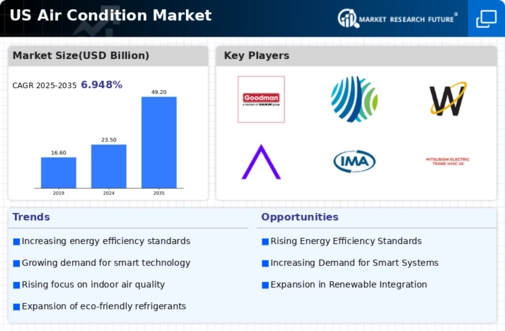Technological Advancements in HVAC Systems
Technological advancements play a crucial role in shaping the air condition market, particularly in the development of HVAC (Heating, Ventilation, and Air Conditioning) systems. Innovations such as variable refrigerant flow (VRF) technology and smart thermostats are enhancing system efficiency and user experience. In 2025, it is anticipated that smart HVAC systems will capture a significant portion of the market, driven by their ability to optimize energy usage and provide real-time data to users. This trend indicates a shift towards more integrated and intelligent systems, which not only improve comfort but also reduce operational costs. As consumers become more tech-savvy, the demand for advanced HVAC solutions in the air condition market is likely to grow.
Regulatory Push for Environmental Standards
The air condition market is significantly influenced by regulatory frameworks aimed at reducing environmental impact. In recent years, the US government has implemented stricter regulations regarding refrigerants and energy consumption. For instance, the phase-out of high-GWP (Global Warming Potential) refrigerants is pushing manufacturers to develop more eco-friendly alternatives. By 2025, it is projected that compliance with these regulations will drive a shift towards low-GWP refrigerants, which could account for over 50% of the market share. This regulatory push not only encourages innovation but also aligns with the growing consumer preference for sustainable products, thereby shaping the future landscape of the air condition market.
Consumer Awareness and Health Considerations
Consumer awareness regarding the health implications of indoor air quality is increasingly influencing the air condition market. As individuals become more informed about the effects of poor air quality on health, there is a growing demand for air conditioning systems that not only cool but also purify the air. In 2025, it is estimated that air purifying features will be a standard expectation in new air conditioning units, reflecting a shift in consumer priorities. This heightened awareness is prompting manufacturers to innovate and incorporate advanced filtration technologies into their products. Consequently, the air condition market is likely to see a rise in demand for systems that promote both comfort and health, aligning with consumer expectations.
Rising Urbanization and Infrastructure Development
Urbanization is a key driver impacting the air condition market, as more individuals migrate to urban areas in search of better opportunities. This trend leads to increased construction of residential and commercial buildings, which in turn drives demand for air conditioning systems. By 2025, urban areas are expected to house over 80% of the US population, necessitating efficient climate control solutions in densely populated regions. Additionally, infrastructure development projects often include modern HVAC systems as standard, further propelling market growth. The air condition market is thus positioned to benefit from this urban expansion, as new buildings require advanced cooling solutions to meet the needs of their inhabitants.
Increasing Demand for Residential Cooling Solutions
The air condition market experiences a notable surge in demand for residential cooling solutions, driven by rising temperatures and changing climate patterns. As average summer temperatures in the US have increased, homeowners are increasingly investing in air conditioning systems to ensure comfort. In 2025, it is estimated that approximately 90% of US households utilize some form of air conditioning, reflecting a significant shift in consumer preferences. This trend is further supported by the growing awareness of health risks associated with extreme heat, prompting families to prioritize climate control. Consequently, manufacturers in the air condition market are responding by innovating and expanding their product lines to cater to this increasing demand, thereby enhancing their market presence.






















Leave a Comment